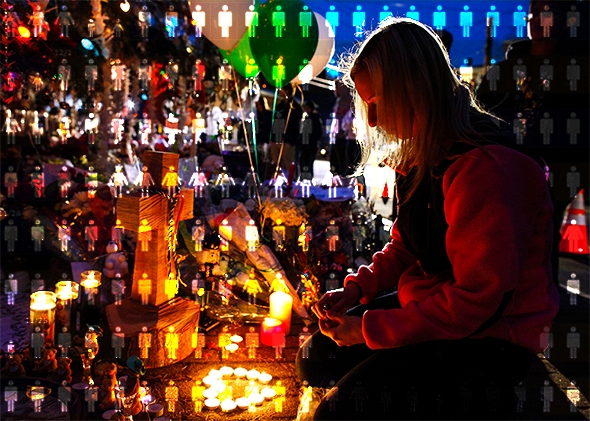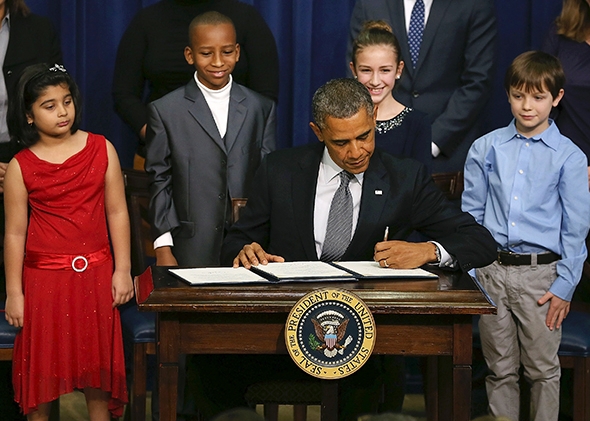A Year of Gun Deaths
What Slate learned from trying, and failing, to record every death by gun in America since Newtown.

Photo illustration by Lisa Larson-Walker. Photo by Reuters
Five days after the shooting at Sandy Hook Elementary School, President Barack Obama delivered remarks in which he stressed that, this time, the national conversation about guns must lead to action. “The fact that this problem is complex,” he said sternly, “can no longer be an excuse for doing nothing.” He also spent a moment noting just a few of the Americans who had been killed by guns in the days since Newtown:
Since Friday morning, a police officer was gunned down in Memphis, leaving four children without their mother. Two officers were killed outside a grocery store in Topeka. A woman was shot and killed inside a Las Vegas casino. Three people were shot inside an Alabama hospital. A 4-year-old was caught in a drive-by in Missouri and taken off life support just yesterday.
At Slate, this got us to thinking: Who were the people who had been killed by guns in the days since Newtown? How did they die? What were their stories? So we partnered with a Twitter user, @gundeaths, who since the summer had been linking to news stories about people killed by guns, and thanks to a lot of overnight coding by my colleague Chris Kirk, we created the first version of our interactive feature, “How Many People Have Been Killed By Guns Since Newtown?”, which used news reports to create an approximate real-time tally of deaths by gun in the United States.
The feature was meant to be a provocation of sorts: We knew that those rows of figures, each one attached to a name, piling atop one another every day, made for an arresting visual, one that might trouble even the most ardent gun-rights supporter.
But as time went by and the interactive was discussed, questioned, and cited, this provocation also became a kind of experiment. How many deaths were being reported on, and how many were falling through the cracks? Why was it that no single source was collecting this data in real time? In other words, we wanted to know if an interactive like this can actually be valuable as something besides a provocation—whether crowdsourcing can produce real-time data and whether that data is useful and complete. (Hoping people might use our data for their own research purposes, we made it available as a downloadable file.)
A year after Newtown, the 11,400-plus human figures on that list remain a chilling reminder of the toll guns take on Americans every day. And the answers to our questions have started to become clear. Some people did use our data, for both interesting visualizations and public programs (sometimes, alas, without reading it carefully first). But we’ve also learned some tough lessons about how hard it is to track death by gun in America. The overwhelming likelihood is that our interactive missed more than half of the gun deaths in the past 12 months. The main reason there is no single source collecting this data in real time is surely because it is an enormous, daunting task—one that we only made a small dent in, with the help of devoted volunteers.
As for the greater question of whether an interactive like this can ever be something more than an incomplete shout in the dark: I think it can, because of a quiet revolution in gun-related research and data collection that is sparking at universities and government agencies in the wake of Newtown. It seems likely that Obama’s lasting legacy on guns won’t be a federal law, but rather a simple executive order he signed on Jan. 16, which helped make this revolution possible. There’s a long way to go, but I think a better, more complete, privately funded version of our gun-deaths calculator could make a real difference. That’s why I’m so glad that a better, more complete, privately funded version will be launching at the beginning of 2014, led by a businessman with a history of using technology to collect and disseminate data. He has a real challenge before him.
* * *
The first, most important question to ask in looking at our year of data collection about guns is simple: Why is our tally of gun deaths in the year since Newtown so much lower than the likely actual number of gun deaths over a year’s time? According to statistics slowly, painstakingly assembled by the Centers for Disease Control and Prevention from death certificates, about 32,000 people are killed by guns in America each year. (In the most recent year for which preliminary data is available, 2011, the exact number was 32,163.) Our number, meanwhile, hovers in the 11,000s.
Our interactive was much more timely than the CDC’s statistics—updated hourly, rather than two years later—and included significantly more information about each death. But as the gulf grew between our tally and the likely actual totals, I began to feel uneasy about our calculator. How could we solve the problem of missing people? How could we make it clear that our total—frequently cited in newspapers and magazines—reflected not the actual toll of guns but the level of reporting on guns in the American media? We added an update in June pointing out the discrepancy and urging readers to consider our number as a measure of reported gun deaths, with the real number much, much higher. But I still wondered: Who was missing from our list?
People like Jonette Harness Adams.

Photo courtesy Jeff Adams
Jonette, a beautician, shot herself on Aug. 28 outside her Bakersfield, Calif., duplex. Adams suffered from spinocerebellar ataxia 2 (SCA2), a rare hereditary neurodegenerative disorder, which among other symptoms impairs motor skills and slurs speech. Her sister, Rebecca Ezell, who also suffers from SCA2, told me that since Jonette’s diagnosis she often exhibited signs of depression. “I’d always try to pull her out,” Rebecca told me.
Jonette owned the handgun, a .38-caliber revolver, a gift from her father years before, as well as other guns she’d inherited from her grandfather. “We were taught gun safety at a very early age,” Rebecca said. Jonette’s husband, Jeff, knew about the guns his wife owned, though he didn’t know where they were in the house. “When she showed me those things,” he remembered, “I told her in a joking way, ‘Keep those away from me.’ I’m not a gun guy. I’ve never shot one. I’ve never been around them. I wasn’t opposed to having them around for protection. I always thought to myself, Man, I should go to a range and learn how to shoot them. But I never did.”
Both Jonette’s sister and husband talked about Jonette’s sly wit and good humor, which eroded into depression as the disorder took away her mobility. Jeff told me he would beg anyone who is considering suicide to please talk to someone. “Talk to a loved one. Tell ’em what’s going on in your head, what you’re thinking, what’s bothering you.” (Another place to find people to talk to is the National Suicide Prevention Lifeline, 1-800-273-8255.) “She kept that inside,” he said. “I wish she had talked to me.”
I asked Jeff if he still had Jonette’s guns. “No,” he said. “The guns are gone.”
Jonette Harness Adams doesn’t appear in our interactive feature because she died by suicide. Her obituary makes no mention of the cause of death, and there was no reason for news organizations to report on it.
Suicides, it turns out, are this project’s enormous blind spot. Most every homicide makes the local paper, even if in large cities these stories are sometimes relegated to a mere news brief. Accidental shootings are usually reported upon, as are shootings by law enforcement and incidents in which civilians kill in self-defense. But suicides are mostly invisible. And the fact is that suicides make up 60 percent or more of all deaths by gun in America. In our interactive, misleadingly, only about 10 percent of recorded deaths were deemed suicides by our crowdsourced categorizers.
Any solution to this problem would require governments in thousands of jurisdictions to upgrade and systematize their death-reporting system or for an organization to patiently contact those jurisdictions over and over throughout the year. But there’s a larger question: Is real-time reporting on suicides necessary? Could it in fact be harmful?
It sure could, says Cathy Barber, director of the Means Matter campaign at the Harvard School of Public Health’s Injury Control Research Center. “Covering the suicide issue is important and helpful,” she told me, “insofar as it helps people to understand that the largest numbers of gun deaths in America are suicides. But there’s a bad side to bringing attention to the data. It may have a demoralizing effect on people who are suicidal.” Studies show that reporting on suicides can prove harmful, especially if the reporting is sensationalistic; it can encourage copycat suicides or simply reinforce and darken the already dark view of the world that a suicidal person sees. References to “waves” of suicides or “surges” in suicides also can lead readers at risk for suicide to view, falsely, suicide as inexorable. I’ve tried to follow the American Foundation for Suicide Prevention’s guidelines for reporting on suicide in this piece. But Barber notes that recent research suggests that even “good” reporting is associated with an uptick in suicides.
So a project like our gun-deaths interactive—and, even more, some future version that utilizes real-time police or medical-examiner data—worries Barber. “I see that as not helping, really, but possibly adding to the damage. It seems more like the kind of thing that would be triggering than in any way protective.”
Now, there’s a counterargument to Barber’s viewpoint: That if such a project contributes to raising awareness about the danger that guns pose for the potentially suicidal, to the point that fewer American households possess guns, the resulting decrease in suicides is well worth the increased risk such a project might create. As guns decrease, after all, suicides decrease. But reporting on the deaths won’t necessarily get guns out of homes—at least not immediately.
* * *
This experiment, like all experiments, produced its share of unanticipated results. Last month we posted a second crowdsourcing initiative, inspired by the GalaxyZoo project, inviting readers to categorize the gun deaths in our interactive as murders, suicides, accidental deaths, deaths by law enforcement, or self-defense. More than 52,000 individual classifications were made, with each death getting classified as many as 11 times, and the results were illuminating—both in what they showed about our data and what they showed about the limits of crowdsourcing. It’s this effort that made it clear, for example, that suicides are drastically undercounted in our interactive. But the volume of contradictory responses—deaths labeled as both self-defense and murder, or murder and shooting by law enforcement—also makes it clear that the causes of many deaths are too complicated (or in question legally) to be classified by a crowd. And what expert could classify them? Do we wait to see how a jury answers the question of, say, murder versus self-defense? That could take years.
These are all questions that the organization taking over (and expanding) Slate’s gun-deaths count will need to wrestle with.

Courtesy of Michael Klein
The Gun Violence Archive is a not-for-profit corporation created and funded by Michael Klein. Klein—the founder of CoStar Group, a real-estate information company, and the Sunlight Foundation, a nonprofit devoted to government transparency—told me in an interview that he created the GVA because “policy requires information. And there’s a dearth of information, particularly going beyond fatalities.” He stresses the GVA’s independence in the group’s mission statement, which notes that Klein “has not been a member or financial supporter of any organization on any side of Second Amendment issues.”
We’ll freeze Slate’s gun-death interactive on Dec. 31, and the GVA anticipates launching on Jan. 1. “The data we put online right away will be more robust than yours,” Klein told me, “but nowhere near what it will be in six to 12 months.” The GVA plans to track gun use not only in deaths but in nonfatal robberies, assaults, accidents, and cases of self-defense. Where Slate depended on news media reports, the GVA already uses information from police departments, mayors' offices, and coroners, with plans to expand those programs soon. “It takes a while to get a model working,” Klein told me. “But once the integrity of what we’re doing is evident, I hope we’ll get buy-in from police departments and city governments to share their reports in a timely manner.”
Do police departments systematically record the kind of data that a comprehensive program like the GVA is hoping to collect? Not always. Police departments in many large cities track gun crimes very specifically on a neighborhood-to-neighborhood basis. But other departments, especially in smaller jurisdictions, do not. Last winter, shortly after the Newtown shootings, the Austin, Texas, City Council passed a resolution directing the city manager to collect data about gun use in crimes in Austin. The resulting report was a significant challenge to assemble, according to Ron MacKay of the Austin Police Department’s Crime Analysis Unit.
“We’re a victim of our own information, so to speak,” MacKay told me. “Data integrity is always a priority. We send out training bulletins to officers all the time. But if I’m an officer and this report is the last thing I’m doing for the day, and it’s cold and wet and I’m trying to get home to my family—well. If there’s a gun on the scene, I’ll probably include that, but I won’t always note if that handgun was a revolver or a semiautomatic.” In preparing the report, Austin officials talked with police departments in 10 other cities of similar size. According to MacKay, most responded, “We don’t track all that.”
This lack of information filters down to researchers. Though most scientists I talked to said that they’d always found individual police departments forthcoming and helpful, I heard widespread frustration that data isn’t systematically available in a more timely manner. “I don’t know why we don’t have rapid case accounts,” said Harvard’s Cathy Barber. “It’s crazy that we are using 2010 data.”
It might help, of course, if the federal government issued directives to local police urging them to systematically record and report firearm data. But who would make such a request? The Bureau of Alcohol, Tobacco, Firearms and Explosives, which for years (as the National Network for Safe Communities’ David Kennedy told me) made it difficult or impossible for local police departments to get basic information about guns used in murders? (This was thanks to the National Rifle Association–supported Tiahrt amendments, which, though weakened recently, still restrict the extent to which the ATF can share information on guns.) The FBI is a possibility; they already collect data on firearms used in murders, robberies, and aggravated assaults for their yearly Uniform Crime Reports.
And then there’s the CDC. The agency assembles the death statistics that social scientists depend upon, accumulating them from death certificates collected nationwide. But that process takes a long time; right now, confirmed totals from 2010 are available, and the center has released preliminary figures for 2011. The center also runs the National Violent Death Reporting System, which was created to track deaths nationwide—but which due to funding shortfalls currently only covers 18 states. (Along with $10 million for firearms research, President Obama’s 2014 budget proposal includes $20 million to expand the NVDRS to 50 states. It remains to be seen whether those sums will make it through appropriations.)
The CDC has a complicated history when it comes to gun-related research. Since 1997, it has been prohibited by Congress from research that may “advocate or promote gun control.” That vague language had a chilling effect on all gun-related research funded by the CDC. “Nothing was explicitly prohibited,” said David Hemenway, director of the Harvard Injury Control Research Center. “But CDC knew if they ever did anything about firearms they’d be brought before House oversight committees and berated. There were all these shots across the bow, saying, Do whatever you want, but if you do the wrong thing, we’ll blow you up.”
But last winter, in the wake of Newtown, Obama signed an executive order instructing the CDC to once again support research on firearms. “CDC seems willing to, you know, say the word firearms now, which they weren’t willing to do before, even in private meetings,” Hemenway said. Other researchers agreed that this is a significant, important change in the government’s attitude toward gun research (though they cautioned it’s only a first step). “It’s not clear which catastrophic event triggered it, but it’s a big change, and it’s a good change,” said Alan Leshner, who oversaw this spring’s valuable Institute of Medicine/National Research Council report on future priorities for firearm research. And Matthew Miller of Harvard’s School of Public Health told me, “It has dispelled the chilling effect that has been a pall over the firearm research community over the last 17 years. It sends a signal that it’s not OK to shun this research for political reasons.”

Photo by Mark Wilson/Getty Images
A year after Newtown, we’re in the midst of a boomlet in firearms research funding—one that may be the lasting legacy of this tragedy. (It’s certainly not new federal legislation, though some states have made small moves, as the map below shows.) “There’s a whole new group of foundations,” said Hemenway. “This month we’re applying for lots of grants on guns from sources that were not available before.” Similarly, Michael Klein’s GVA represents a significant investment of private wealth in the study of guns in America.
Gun Laws Passed Between the Newtown Shooting and Dec. 12, 2013
Click on a state to learn more about its new laws.
And private money is crucial, because despite the warming at the CDC, the federal government’s spending on firearms research is still surprisingly low. The president’s $10 million pledge to the CDC was a vast improvement over the near-nothing the government devoted to firearms research before. But Harvard’s Matthew Miller was blunt. “A single-year $10 million investment is, at best, going to result in a few decent studies. It’s possible this becomes a recurrent funding stream, and that’d be better. But $10 million is a paltry sum compared to the billions of dollars spent studying other causes of morbidity and mortality in the U.S.”
Miller pointed out that firearms-related mortality is responsible for more deaths under the age of 40 than any other cause. “You can’t point to any disease that kills this many people. There’d be an enormous outcry if we only spent $10 million on cancer in children, for example. This is the way the conversation needs to go.”
But of course guns are different from other causes of morbidity and mortality. There’s no pro-cancer constituency in America; no right to cancer is enshrined in the Constitution. Even if we spent $10 billion on gun research, could that research actually effect change? The key, researchers believe, is in treating guns not as a political issue but as a public health problem—one in which the only way to change minds is demonstrating that certain concrete steps definitively cause fewer deaths. That’s how this summer’s IOM/NRC report treats guns. That’s why Cathy Barber, for example, discourages anti-suicide messages that are also anti-gun messages. It stands to reason, she says, that such messages create bad results. “People in households with guns are at a three-times greater risk for suicide in America,” she told me. “If they’re a higher risk group, you want to get a message to them, and the way to get a message to them is not to talk about how horrible guns are.” She points to a program in New Hampshire in which gun shops posts warnings and messages about suicide as a positive step.
But in order to test the efficacy of programs like that—public health campaigns designed to save lives immediately—you need current, reliable data. And that’s why I have high hopes for Michael Klein’s Gun Violence Archive. Why should we have to wait years for the CDC to issue a list of numbers, with very little additional data attached? Why can’t we test the programs and ideas that might save lives now? Slate’s gun-deaths interactive started life as a provocation, and it ends its time at Slate as a flawed experiment. But in its new life, we hope it might yet be a lifesaver.

